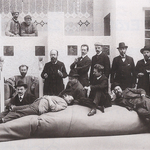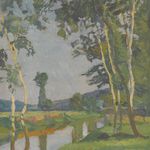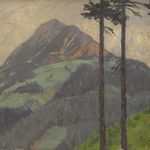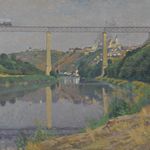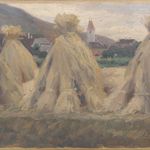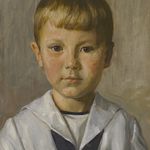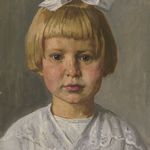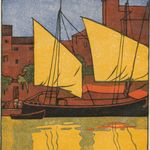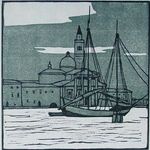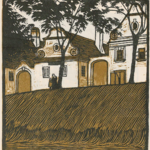Anton Nowak

Anton Nowak
Painter and Printmaker (1865–1932)
A joint project of the Maribor Regional Museum and the Maribor Art Gallery
UGM Kabinet, Strossmayerjeva 6
5 February - 11 September 2022
curator: Andreja Borin
Anton Nowak, a Maribor-born painter who was academically trained and earned a reputation for himself in Vienna, has his first exhibition at Maribor Art Gallery (UGM). He was a founding member of the Viennese Art Nouveau movement and headed a painting school in Brno—but he remained almost unknown to Maribor and Slovenia. The artist's sister, who stayed in Maribor with her family until the conclusion of World War II, donated Nowak's paintings from the artist's estate to the Maribor Regional Museum in 1945.* Around 70 of Nowak's paintings were gradually relocated to the Maribor Art Gallery's collection, while a handful remained in the Maribor Regional Museum's collection. Only a few basic biographical data about the artist were available until recently, and both institutions have dedicated themselves to investigating his life and work. Dr Valentina Bevc Varl, a museum counsellor at the Maribor Regional Museum, has researched Nowak's life and discovered many details and interesting facts that shed light on the artist's life and career.
The painter and printmaker Anton Nowak was born in 1865 into a German-oriented family in Maribor. His father was a bookbinder and owner of a stationery shop.* The family had six children.* Nowak studied painting at the Vienna Academy of Fine Arts after graduating from Maribor's grammar school. In 1886, he finished his studies and went on to study historical painting under Leopold Karl Müller. In 1890, he exhibited for the first time at the 19th exhibition of the Vienna association of artists at the Künstlerhaus, when he became a regular member. He became involved with a new association created around its major protagonist Gustav Klimt as a young painter, and was one of the founding members of the Vienna Secession in 1898 (an association of Austrian artists that included painters, sculptors, and architects). He participated in their inaugural joint exhibition in 1898, as well as a number of later Art Nouveau exhibitions. He was president of the Vienna Secession movement from 1908 to 1909, and he also served as treasurer or a member of the executive committee for several years (of which architect Jožef Plečnik was also a member). The twentieth volume of the 1903 edition of Ver Sacrum (Sacred Spring), the official journal of the Vienna Secession, is devoted exclusively to Nowak's woodcuts. In 1908, Emperor Franz Joseph presented him with a high honor, which was also reported in the Marburger Zeitung.* At the Association's 10th exhibition in 1901, his painting Evening. Isonzo Valley was purchased by Theodor von Hörmann'sche Stiftung for the Museum of Contemporary Art in Vienna (today's Belvedere); there are a total of seven Nowak paintings in the Belvedere collection. Another two are in the Moravská galerie collection in Brno. Nowak's paintings are also sold at auction, and it is possible that a significant number of them remain in private hands. According to the portraits in the UGM Collection, he also produced portraiture for private clients. The painter kept in touch with his family in Maribor and paid them frequent visits.* He may have also painted some Maribor motifs, which remain unknown at this time.
Nowak made a name for himself as a landscape and portrait painter. He lived in Vienna and travelled much around the Austro-Hungarian Empire and abroad during that time. He managed a painting school in Brno, where his wife was born, and spent a lot of time there during the summers.* He was a prolific painter. As a landscape painter, he preferred to paint attractive vistas, historic cityscapes, and castle ruins. Hills, seascapes, and lakescapes were also common in his ouevre. His woodcuts, published in the magazine Ver Sacrum in 1903, show the influence of Art Nouveau in some individual elements, as well as in the expression with flowing lines and uniform colour surfaces, but, for the most part, he remained faithful to a solid, realistic rendering and classical perspective in his woodcuts. Some of the vistas and motifs also appear in his paintings, but these are the only prints we are aware of at this time. The strict academic realism is only traceable in a few of his paintings, as his later paintings are based on colourful, bright naturalism with echoes of plein-air painting. We also see examples of neo-impressionism after 1893, which was most likely influenced by the Austrian impressionist painter Theodor von Hörmann, who became acquainted with impressionism during his sojourn in Paris (1886–1890) and exhibited his impressionist works in Vienna in 1893. Other neo-impressionist painters may have had an impact, although this course did not continue in Nowak's work. In some of his studies and paintings, according to the Austrian Biographical Lexicon, he resembles the Belgian painter Théo van Rysselberghe in his use of vast patches of colour in bright tones. Anton Nowak was obviously very erudite and well-versed in the prevailing artistic tendencies of the period. The slender larch trees on the right side of the painting Mountain Landscape (Rettenstein near Filzmoos) from 1905 stand out. Nowak may have taken the composition and placement of the larches with their thin trunks and first branches below the top of the painting from Italian painter Giovanni Segantini, who was known for his pastoral Alpine landscapes and was one of Europe's most famous painters at the end of the 19th century. Ivan Grohar's iconic painting The Larch was influenced by Segantini's tree placement. The extremely slender, leafy trees with long trunks and branching crowns that can be seen in some of Nowak's paintings, which have many parallels with the works of members of the Vienna Secession movement and artists who published in the magazine Ver Sacrum, are another example of inspiration from his contemporaries.
Despite the positive reception of many styles in Anton Nowak's work, the artist never succumbed to new trends and did not continue in this way. The paintings in Maribor Art Gallery reveal him as a realist who incorporated elements of plein-air painting on occasion and brightened his palette with pink, purple, and grey tones as a result of a new perception of light. Within his landscape repertoire, he occasionally adopted motifs and inspirations from his contemporaries, while remaining a moderate traditionalist in his painting style. Since his time at the Academy, he loosened and prolonged his stroke, but he never truly let go into the unknown, instead continuing to employ a stroke with accuracy and consistency to create a compact and somewhat closed visual surface. Secession's impact appears to be more visible in his woodcuts than in his paintings, and is limited to particular pieces and even individual elements. Despite the fact that Anton Nowak was not an innovator, he was an active artist in Central Europe, particularly in Vienna.
He left a substantial legacy to Maribor, which has been professionally examined for the first time exactly ninety years after his death. The intial step is to present his life* and oeuvre within the Maribor Art Gallery collection; nevertheless, further research might surely be conducted. Nowak's story also adds to our understanding of the German minority's contribution to the city's creative output. It is most likely that his ethnicity as a member of the German minority has kept him virtually unknown in his hometown of Maribor, and it is further due to our lack of knowledge that he has not been effectively represented in survey exhibits or in Slovenian fine art lexicons. Maribor Art Gallery is, in a sense, reinstating the artist's place in the UGM Collection, in Maribor, and hopefully beyond, with this initial step. Welcome home!
*Biographical data taken from the research of Dr Valentina Bevc Varl, a museum counsellor of the Maribor Regional Museum. The paper "THE LIFE OF THE ACADEMY-TRAINED PAINTER ANTON NOWAK (b. Maribor 1865, d. Vienna 1932)" was presented at the international symposium Museoeurope 2021, which was held in October 2021 at the Maribor Regional Museum.
